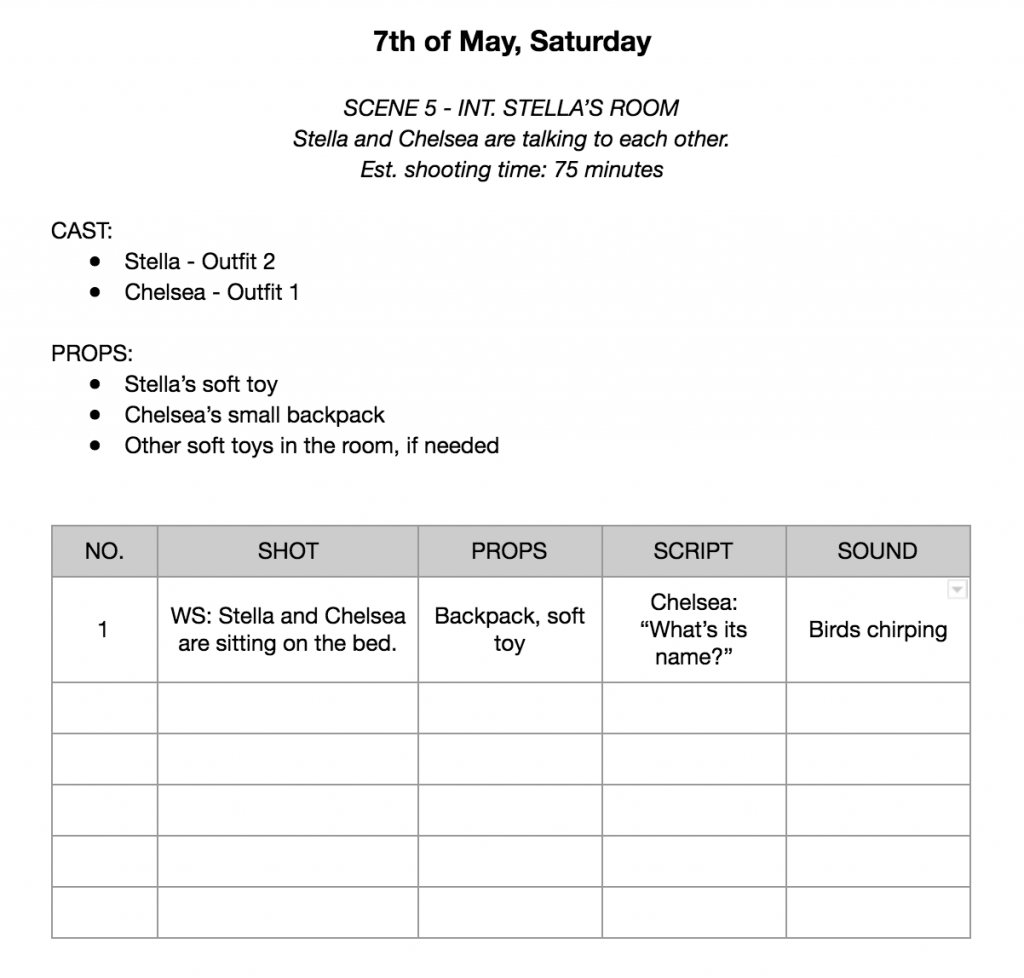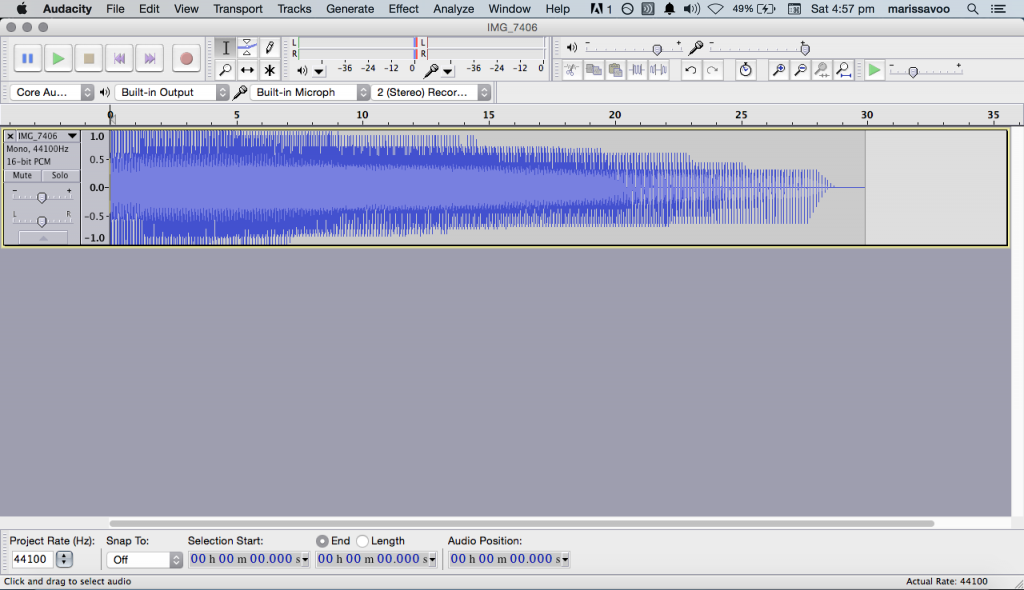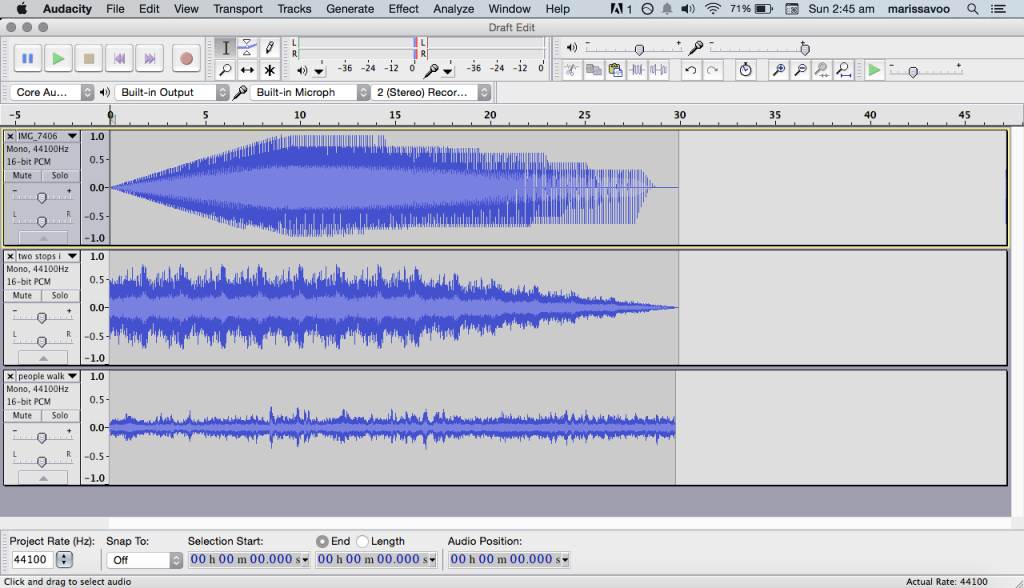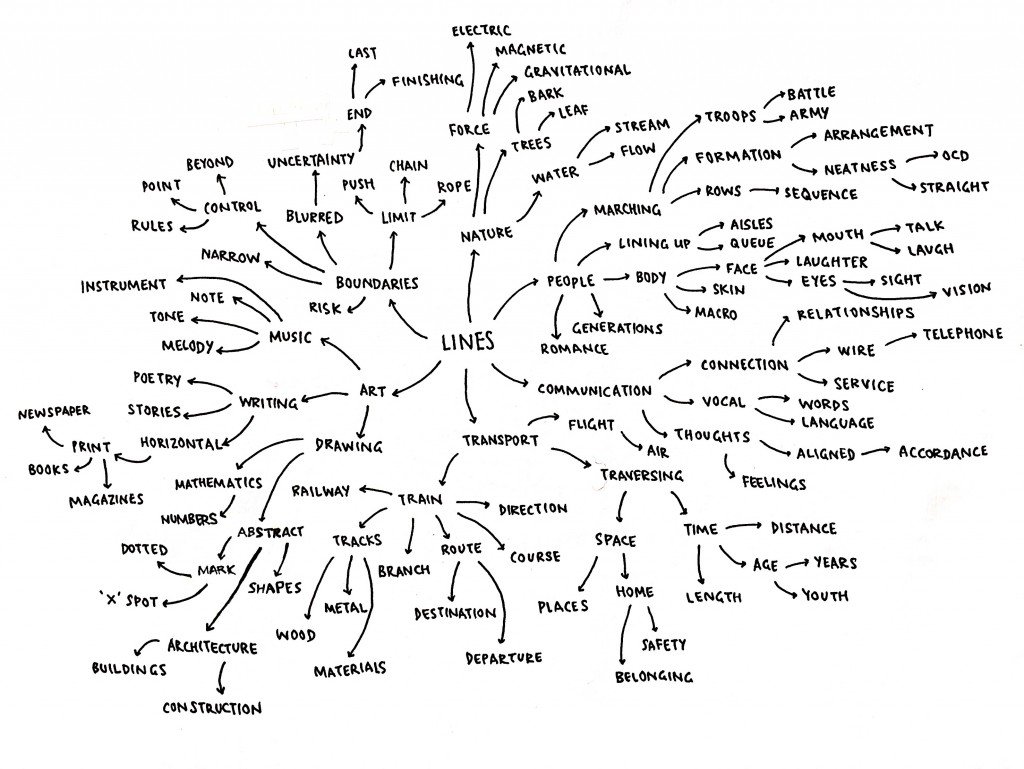Archive of ‘Assessment progress’ category

I had never done a shooting script before, so this was a new experience for me. I looked up a couple of examples on Google Images, and eventually arrived at this point, which you can see in the screenshot above.
This was a bit of a challenging task, as I had to dissect the script I had written into parts and scenes, and think about how I might fit that into each of our shooting days. We were initially thinking about shooting on two Saturdays, which is the 7th and 21st of May. We might change it to a weekend, on the 7th and 8th of May, but that’s really dependent on the actors and their availability.
Some of the things I had to think about while compiling and organising the shooting script were things like:
1) Allocating an estimated time to shoot each scene
2) Following actors’ schedules and availability
3) Coherence of outfits while shooting different days
4) Not keeping an actor waiting for too long while shooting another’s scene
5) Considering time for recording other remaining audio, etc
The shooting script is still in progress, but can be viewed here.
To elevate the severity of imaginary friends and the dark or creepy preconceived notions of it, we decided that our short film will have a lighter take, almost calming in nature and close to the heart. We want to illustrate the story of this innocent young girl and her journey in discovering life outside of her own imagination.
These are snapshots from some films that caught my attention. All of them involve child actors. More than that, though, is the fact that each of them are very visually appealing and warm in tone.

We want our short film to have a warm, homey vibe. Below are some pictures I got off Pinterest to illustrate the sort of places and feelings we are going for.

For the children’s clothes, I decided to go with something basic; nothing too quirky or fancy. The two little girls in the film will possibly be barefoot and wearing pretty dresses – illustrating their innocence.

The boy, on the other hand, will be slightly dishevelled when compared to Stella, away from the conventional neatness that kids at home or school have.

The clothes that they wear need to be in line with the ‘characters’ attitudes, socioeconomic status, self-image, and degree of concern for appearance’ (Gitner 2016). In this case, Sam is somewhat of an outcast, only visible to Stella. He doesn’t exactly have a place in the reality in which the rest of the characters exist – this seemingly ‘perfect’ world – and so by setting this wardrobe, he is depicted as somebody a little out of place.
REFERENCES
Gitner, S 2016, ‘Multimedia Storytelling for Digital Communicators in a Multiplatform World’, Routledge, New York, p. 253.
Late Bloomer 2004, short film, directed by Craig Macneill.
Marry Me 2009, short film, directed by Michelle Lehman.
Moonrise Kingdom 2012, film, American Empirical Pictures, & Indian Paintbrush, USA.
Small Deaths 1996, short film, directed by Lynne Ramsay.
After having Robbie see my two previous posts, he gave me some feedback regarding the use of text for my 8-second clips and how it is as if I were telling the audience exactly how I wanted them to read it. That did make sense. So after discussing it further, I went with leaving out the parts that said “Part I”, “Part II”, etc, but kept the main points that said “Future”, “Passion”, etc.. Robbie also mentioned something that was helpful to my video, which is the fact that the crossbars might block my text, which is why I ended up blowing up the entire four screens with it. Below are my edited clips compiled in one video.
Also, I re-edited my audio by lengthening my first draft to 30 seconds. For the second channel, I shortened it and allowed it to start a little later. I edited the third channel exactly the same way, but against the second track. Here is a visual picture of what it ended up looking like.

Below is my final edit of the audio that I will be submitting for the exhibition at SIGNAL.
Above is the final edit for my film sequence. I initially encountered some problems with positioning the frames such that it would not be blocked by the metal crossbars at SIGNAL. However, I managed to overcome that issue with some advice from Robbie and careful positioning.
The ideas behind the series can be found here.

I decided to give it another go, and the sound waves actually turned out the way that I had wanted it to! The sound waves faded off to nothing (as pictured above) and I was actually quite surprised that it did. Initially, I had to fade it out in order to achieve that effect. This time, it happened voluntarily.
I wanted this to represent life in general – how life starts out, we go through the busyness and confusion of every day life, and eventually die. As I thought about the next two tracks for my 3-channel audio, I wanted another to represent the people in your life; the interactions and relationships you make with other human beings, and how they come and go as well. For the last track, I was looking to record sound from people just coming out of the tram and walking along the streets, signifying how the world around you continues on despite your birth, busyness, and death.

Above is the visual image of my edited sound waves. What I want to achieve from this experimental sound is something symbolic in nature, referring bits of a single element to our everyday lives. Following up from what I explained earlier, here are the individual tracks with a detailed explanation of how and what I did to achieve my desired sound.
Channel 1 – Self
https://soundcloud.com/marissa-963960003/self
For this audio, I chose a small segment from the original audio clip, where I recorded sound from a moving tram. I then amplified and stretched it, producing a visually satisfactory track that represented what I was looking for. I faded it in as well to avoid abruptness.
Channel 2 – Relationships
I sat in a tram, and recorded audio from inside. As I listened to my recording later on, I decided to pick a small part where the doors of the tram where closing, producing a beeping sort of sound that reminded me of cardiac monitors at hospitals. Using that small bit of audio, I duplicated it several times to fill up the 30-second audio track, and faded the audio out. I also used noise removal, where I chose a small bit as a profile before applying it to the rest of the audio. It turned out to be pretty interesting because the voices of the people on the tram that day turned out to be very muffled as compared to the beeping sound of the closing doors. I wanted this to represent the lives of people that come and go from your life.
Channel 3 – World
https://soundcloud.com/marissa-963960003/world
This audio is a recording of people coming out of and going in to a tram. I left this piece raw and unedited, representing the world and environment around you, and how it carries on despite your life and death.
As of right now, I don’t quite know how another person might feel about my piece if they were to listen to it at SIGNAL. However, I’m quite satisfied with this progress so far and I hope that others would be able to listen to this 3-channel story and conjure their own interpretations. Below is the completed edit, a compilation of all three 30-second pieces.
https://soundcloud.com/marissa-963960003/completed-edit
Following up from my previous post, I decided to take a short train ride to capture some audio. For the above clip, I took a small snippet out of my recording, then amplified, stretched, and faded it out to achieve the above track. It did not quite meet my expectations, honestly, based on what I initially wanted, but Robbie encouraged me not to give up, and to continue experimenting.
I believe that there is still some potential. However, now having a clearer idea of what is expected for this project, which is a 30-second piece (with 3 channels) I’m going to further expand my idea by possibly stretching the audio even longer, maybe adding a reverb, and recording some audio from the train station, like announcements or the busyness during rush hours.
By playing around with the sound waves and perhaps taking into consideration the busyness that people go through in their everyday lives, my idea is to create it such that it becomes a story – a story of how we are so busy with going about our daily routines, with so much worry about what the future holds and how they might sustain a lifestyle, that they forget to slow down and enjoy life as it comes, for we all eventually end up with nothing.
Looking back at the mind map I made, I decided that I would like to create sounds associated with my initial thought of ‘lines’ as part of a particular thing or a metaphor.

Drawing from my video ideas and thinking about how train lines can signify our future, for example, I might want to record audio from on the train and tweak it such that the crest and trough of the sound waves would represent a ‘rollercoaster’ life, indicating uncertainties, and the ending stagnancy would signify how we all end up in death.
My second sound idea might revolve around communication, what with telephone lines and lines spoken over the phone. Here I thought of recording the ringing of a telephone, and someone picking it up and saying, “Hello?” I intend to record a few people saying “Hello?” to indicate how we, despite being completely different human beings, would begin a phone call with the exact same line of communication.
My last idea is still something I’m thinking about.
The idea of ‘obsession’ wouldn’t quite be complete if it didn’t refer to something that plays a significant part of our lives, would it?
The more I thought about the idea of lines, the more I wanted to associate it with my own life. As I began to closely study the concept map I had come up with, I started to see how one thing linked to another… It wasn’t long before I saw the association lines have with life, as a whole. The following image will give you a brief idea of my first train of thought:

The idea I had conjured involves four different themes. Utilising the four screens, I wanted to create a story that would resonate with SIGNAL’s own surroundings. The two screens connected by the corner of the building would be visually different, but married in significance; I will name the screen on the right, A, and the screen on the left, B.
Humanity
Screen A – There is a barcode being crossed out, just like tally marks on a prison wall.
Screen B – A person is smiling or laughing, but he/she then wipes the smile off from his/her eyes.
This theme refers to the ‘human barcode’, where by there had been some controversy regarding electronic ID chips being assigned to each person upon birth. I wanted to use this to signify humanity, and how the happiness in one’s laughter lines are slowly being robbed by the things of this world.
Relationship
Screen A – Some tree branches are moving towards the opposite side of the screen.
Screen B – A person’s hand is reaching out towards the opposite side of the screen.
What I want to signify through the 8 seconds is the relationship people have with what is around them – in this case, nature. I intend to use the hand of someone who has very prominent veins, such that the veins in his/her hand identifies with the branches of a tree. Our bodies are made up of dust and billions of atoms, much like every bit of nature around us.
Future
Screen A – A girl walks along some train tracks, with a map in her hand.
Screen B – Overhead power lines, expanding from few to many.
With the future holding so many ideas and uncertainties, I want this idea to stem from something we all go through as human beings. There is an unknowing look on this girl’s face, as she tries to decipher where she is heading. The overhead power lines signify something that is above, a Higher Power, and how there are many possibilities to every problem and decision.
Passion
Screen A – A girl is doing arabesques.
Screen B – Lines are being drawn across a piece of paper.
The arabesque is a ballet position, and this performance dance is one that places a lot of emphasis in having your body at straight angles. Art is something that brings people together, and I want to show in this theme, how passions are different but intertwined. Here I use drawing and dance to illustrate how they are both associated with one another.
The ideas I have for this project are concise, but may however alter as I begin to shoot it. Also, there might be many ways in which the audience may interpret my work, and I look forward to seeing what sort of effect it may provoke.
 As I sat at home and began to brainstorm for ideas, I began to think about ‘lines’ not just as long, narrow stripes, but as part of an object or even a metaphor.
As I sat at home and began to brainstorm for ideas, I began to think about ‘lines’ not just as long, narrow stripes, but as part of an object or even a metaphor.
For instance, the phrase “crossing the line” could indicate things like limitations or boundaries, or something that is beyond your control. People lining up, on the other hand, gave me ideas of how the body is capable of creating rows and formations, and how the body itself too has lines – laughter lines, and also lines of sight and vision. In art, lines are visible not only in drawings but in poetry and music, reminding me of things from abstract shapes and instruments, to printed materials and architectural significance. What about telephone lines? They portray communication and relationships, words and language.
The possibilities are almost endless, how one thing is capable of linking itself to another, and being obsessed with that one thing has helped me discover more than I had initially imagined. Now, the thing to think about is how I might illustrate that in the form of a video.
“You never quite know [how the project will be] until you’re installing it and you see it run for the first time; how the space is going to shape the project.” — Marcus Cook
For our third assessment, each group was given the opportunity to meet different artists, individuals who have previously utilised the Testing Grounds space for their projects. Marcus Cook of Shogun Lodge Services was our designated artist, and we had the honour of arranging an interview with him. We were unable to find much information about Cook off the Internet, so meeting up with him and listening to his stories and experiences was indeed a privilege.
Having had a dinner party at Testing Grounds with my fellow classmates a couple of weeks back, I kind of had an idea of what it felt to be in that sort of space, using it in unconventional ways. In Cook’s case, he set up a distance-based sensory project in which several sensors were placed around Testing Grounds. Brandon LaBelle (2004) describes “sound installation art” as work in which “sound [is positioned] in relation to a spatial situation, whether that be found or constructed, actualised or imagined”, and how it has reimagined the social-spatial power. As people moved around, and noise and sounds from the environment took their course, information was then collected on a network and sent back to processing computers that in turn, modified video projections that were displayed on the walls of Testing Grounds.
According to musicologist Helga de la Motte-Haber (1999), she suggests, “Located beyond the realms of the traditional art world, installations created a new consciousness of our perception of reality. Here, the public was also granted a new authority”. This was evident in Cook’s project at Testing Grounds. He talked about how he can never predict how people would interact with his invention. “There is a feeling of [the project] being a larger thing in that particular sort of space because of its flexibility and openness … If you’re building things you want other people to use, it’s one of the things you have to sacrifice very quickly – or, it gets taken away from you,” Cook says.
In Born’s Music, Sound and Space, Ouzounian (2013) talks about the “extended spatial imaginings within music” and how it brought about new relationships and experiences with audiences, especially the “repositioning of audiences as co-creators of music”. She emphasised a particular course at the New School for Social Research and how it essentially proposed audience-interactive works. Much like Cook’s installation, he was able to see people do things completely different from what he intended, and how that was actually one of the greater things about his discovery. “It reminds you that you don’t know everything,” he said with a smile.
Cook also mentioned that he used to see these things as somewhat fleeting; something that you had to experience for yourself as you are in that moment, knowing that it wouldn’t always be there. In the same way, Ouzounian (2013) talked about sound as sculpture, and how they were sometimes “particularly ephemeral, consisting of actions so incidental or brief”. Cook’s approach towards Testing Grounds was an experiment, and he found great pleasure in watching people interact with his work, seeing how the visuals projected on the walls would change, shift, and shape. More than anything, they were moments that happened once and were significant for that segment in time; sequences that changed every other second.
Listening to Cook talk about his experience with Testing Grounds, as well as sharing about some of his fellow artist friends’ works, reminded me that art is an important, collaborative effort that brings people together. His source of inspiration does not only lie in the people who come across his installations, but also the people who have utilised Testing Grounds just as he has, like his friend Keith Deverell. These artists have “imagined new interactions with their publics” (Ouzounian 2013) and thought of ways that these audiences are able to work hand-in-hand with what the artists themselves have created.
Overall, this documentary project was a fascinating experience as it opened my eyes to the various artists and their capabilities; their wild ideas and determination to make it work. By relating Cook’s work to Ouzounian’s take on sound installation art (together with her usage of ideas from various professionals), I gained a better understanding of how his work found its place in the world, and how interactions are formed and regulated to create brand new discoveries. More so, it has further sparked my interest in Testing Grounds as a space (and place), and how so many artists have once formed a temporary home in its margins, not forgetting the many collected encounters that have come together with it.
REFERENCES
Cook, M 2015, Shogun Lodge Services, online, viewed 13 September 2015, <https://www.facebook.com/shogunlodge>.
Ouzounian, G 2013, ‘Sound installation art: from spatial poetics to politics, aesthetics to ethics’, in Born, G (ed.), Music, Sound and Space, Cambridge University Press, UK, pp. 73-89.










